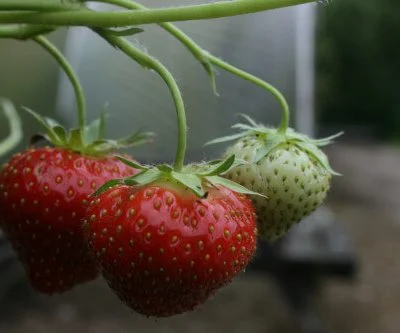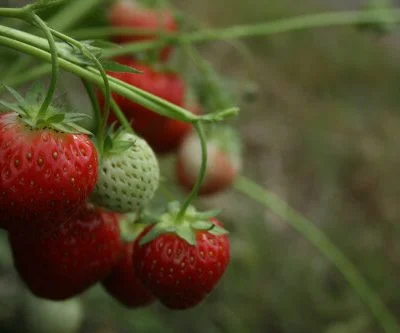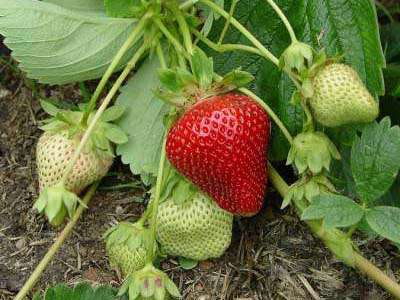Your basket is currently empty!
Strawberry Plant Care
Regular feeding is essential for the best results from a strawberry bed, try not to simply add some fertilizer on planting and then assume that this will do them for subsequent years. An annual top dressing – again with growmore, bonemeal or seaweed maxicrop will give much increased yields and also aids fruit quality and the health of the plant. The feed you added at planting time will quickly become used up or it will leach away through heavy rain. So make sure you top it up, at least annually in early Spring, and again in early Autumn after the plants have been cut back.
In late Summer or Autumn, when the plants have finished fruiting it is a good idea to trim away all of the old foliage. Treat each plant individually and give it a good haircut with shears or a large pair of scissors. Cut it right away to near the crown, taking care not to ‘pull’ at the plant to remove the growth, as this might loosen the plant in the soil. Strawberries are quite shallow rooted and sometimes it doesn’t take much to dislodge them. The reason you are removing all this old growth isn’t just for tidiness sake – although you will find your strawberry bed looks a whole lot better as a result! But more importantly you will find diseases and bugs and creepy crawlies will be much less prevalent as they will hide in the old leaves. Getting rid of the old leaves gets rid of them too. Dead foliage and stems will also harbour fungal diseases.
Most varieties will produce some new growth in the 2 or 3 weeks following this ‘pruning’ and the plants will look quite fresh and invigorated before winter sets in. Now is a good time to add some fresh fertilizer, after you have cleared away this unwanted top growth, rake in some granular fertilizer. Also water the ground if it is dry as it often can be at this time of year, especially where large plants with copious leaves have shaded the soil from the rain.
Harvesting
So you have followed all these instructions to the letter, your plants are bonny and healthy and cropping merrily away. That’s it, right? The spoils are yours to collect. Wrong! It would be a shame to spoil the perfection of your berries by picking them the ‘wrong’ way. There are a few do’s and don’ts when it comes to picking strawberries.
Try to handle the berry itself as little as possible. Handle it by the stalk and pinch the stem just above the calyx [the little ruff of leaves just above the berry] to detatch it. Don’t hull the berries when you are picking them, that should only occur just before you are going to eat them. Make sure the berries are properly ripe – too pale and they won’t have developed flavour and sugar levels properly and if they are too dark they will have gone over and have a slightly winy or ‘stewed’ flavour. Different varieties have a different colour and some will be darker than others – observation and experience will soon tell you when the varieties you are growing are at an optimum level of ripeness.
Avoid picking during the day if at all possible – when it is cooler, in the first part of the morning, or the evening is better. And it inadvisable to pick during rain or when the fruits are still wet, if at all possible.
Place them carefully in a basket or punnet and try not to be heavy handed. Remember they bruise easily, and are more delicate than commercially sold samples from the supermarket which have been raised to have tough skins so that they travel and keep well.
If you are growing or picking for jam making then this attention to detail is not so important and you will also be able to hull the fruits as you pick, thus saving a job later on.
Frost protection
Is especially important at flowering time. The plants themselves seldom suffer with frosts or cold even in extreme conditions. But the flowers will appear in May, sometimes even earlier and that this time frosts can still occur. Strawberry flowers that have been frosted are easily identifiable because the centres turn black. Fruit set will be compromised and the berries that do form may be mis-shapen. The easiest way to protect small numbers is with a cloche or you may wish to infest in some horticultural fleece which can be spread over the plants at night time. It is important to remove this during the day so that pollinating insects can visit the flowers. On windless nights even newspaper placed over the plants can help prevent frost and is a quick and easy way of protecting them.
During fruiting
There are 3 key aspects to remember at this crucial time. Protection from birds; adequate water supply – and keeping the berries clean.
As the fruit trusses begin to appear in May and June provision must be made to keep them clean because otherwise, as the berries swell their weight will bring the trusses down on to the floor. Heavy rain will splash mud all over them and this in turn can lead to rot or botrytis. So for the nicest, cleanest, shiniest berries that you can eat straight from the plant, or carry to the tea table with pride, you need to provide a medium between the fruits and the ground. By far the commonest and easiest method of doing this is to spread straw around the base of each plant. It is cheap, readily available and it really only takes a few minutes to do it. The straw can be raked away when you are removing the spent growth in the Autumn and fresh applied next year. The only drawback with using straw is that in the Spring you are liable to get some self sown wheat seedlings appear but these are quite easy to deal with. Other mediums that you can consider are bark chippings and ground-cover matting.
Protection from birds – and also wasps and squirrels.
Depending on where you live this is a must-do. Urban areas, or if you are growing in pots on the patio or very near the house, may suffer less from birds and squirrels. But elsewhere they are likely to get the fruits before you do. The ideal is to grow your strawberries in a fruit cage which is a real joy in the garden and can of course also find home to any number of soft fruits and dwarf fruit trees, all of which can be housed in this environment, smug in the knowledge that all is safe from predation. If you haven’t the recourses or space for a fruit cage then the next best thing is to cover the fruiting plants with netting supported with some pea sticks. It’s easy enough to do but you will need to remove it when you want to harvest which can be a bit irritating, especially if you are in a hurry. There are many bird scarer devices on the market that you might want to try. Strands of wire spread across the strawberry growing area can also help deter some birds such as pigeons but is less effective where the culprits are persistent.
Additional irrigation during the cropping season is vitally important to gain the heaviest crop and the largest, juiciest berries. Nothing is more likely to effect the size of the berries than a shortage in moisture at the crucial time when the berries are swelling. There may have been a few showers around, or even a period of rain, but the truth is it needs to rain an awful lot during the summer to do any actual good. This is because so much of it evaporates quickly in the warmer temperatures, or is shielded from the ground by foliage. So be prapred with a hose if your planting area is fairly comprehensive. This will ensure you can puddle around the plants and give them a really good soaking, a watering can is ok for just a few plants but if you’re tending to a dozen plants or more a hosepipe nearby will make sure you are more generous with your water application. You can invest inan oscillating sprinkler which you can leave on for an hour or so and is much less time consuming, but these devices tend to be less specific about where they spread the water and a lot is wasted. And you don’t really want to wet the leaves any more than is necessary because this can encourage fungal diseases. It is best to water around the base of the plant, at the roots where it is really necessary. In all cases the best time to water is in the early morning or the evening when temperatures are cooler and the water will be absorbed more readily by the plant, before it simply evaporates away.
Protection from rabbits and deer
Both are very partial to strawberry plants alas. Be on guard for even in urban area’s rabbits and deer are an increasing problem. The good news is that even plants that have been nibbled tend to grow again quite quickly because in their habits both rabbit and deer tend to take the top most leaves, and the crown will grow again quite quickly. Take this as a warning sign and erect a fence or cover the plants to prevent further attacks, which will as time goes by weaken and destroy the plants.
What to do with all those runners……!
As your strawberries grow and mature they will start to produce new baby plants on the ends of long runners. If left these new plants will root into the soil and make new ones. Allowing reproduction to occur untended will result in a congested and unruly strawberry patch! It’s best to direct the new runners into any spare spaces or gaps in the rows where they can grow and fill these spaces in, and keeping the paths between the rows clear. Excess runners should be cut off and either discarded or potted up to populate a new bed. The number of runners produced will vary with the variety, some are much more prolific than others. Autumn fruiting, perpetual and day-neutral varieties produce far fewer runners, and sometimes none at all.






